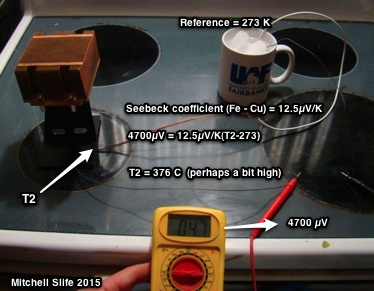Temperature from Voltage
There are two principles or effects that allow us to determine temperature from voltage. The Seebeck effect and the Thomson effect. William Thomson, later Lord Kelvin, discovered that heat can be absorbed or released in a conducting element depending upon the direction of the current. This could also be stated as electrons will diffuse with the differential heating of an element, and this diffusion is specific to the conductor's composition.

Thomas Seebeck discovered that if two dissimilar conductors were coupled and heated at one junction a potential would develop between the ends of the conductor. Seebeck investigated the relationships of different conductors to each other and found an organization much like static charge's triboelectric series.

The proportional change of voltage with temperature across a thermocouple allows us to determine temperature at the joint: V = αΔT where α is the Seebeck coefficient, measured in Volts/Kelvin. A linear increase in voltage with temperature can be assumed for temperature changes within several hundred Kelvin.
